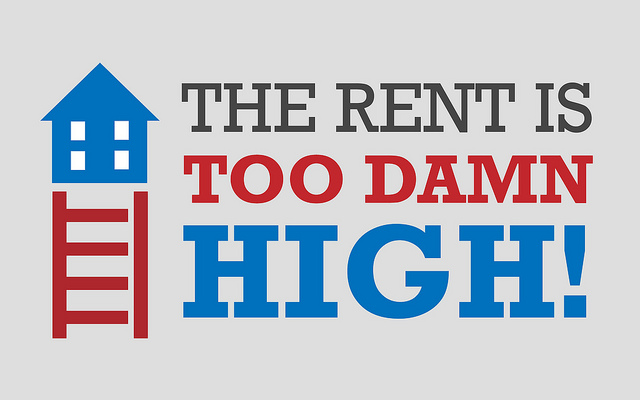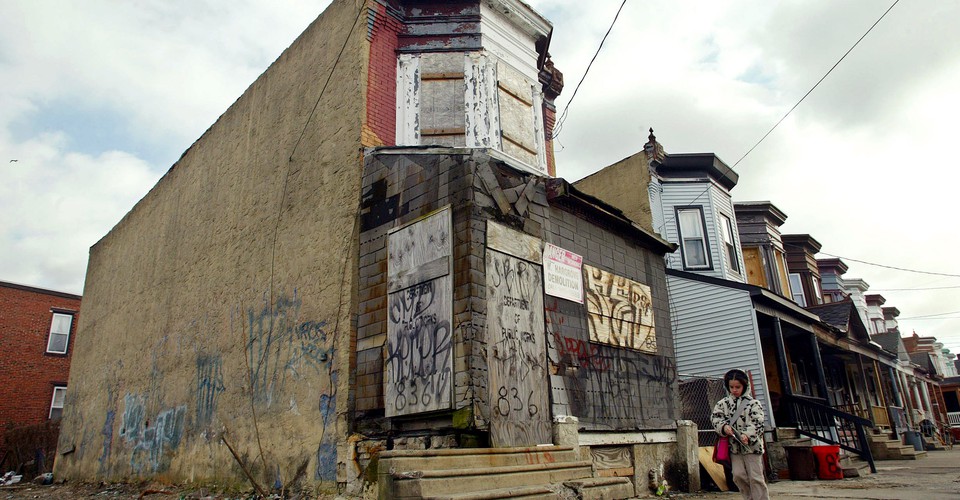class: center, middle, inverse, title-slide # Econ 414 - Urban Economics ## Housing Policy ### Marcelino Guerra ### March 25, 2021 --- # Motivation .pull-left[ * We already saw many government policies that affect housing, such as land-use regulations and the tax subsidy to homeownership * Now, we analyze additional public policies in the housing market: rent-control laws and housing-subsidy programs * Rent control benefits current tenants in the short-term but has pervasive long-run effects on overall welfare * A less distortionary policy is to offer a subsidy to specific groups. However, each program involves opposing interests between the ones who finance the assistance (taxpayers) and the targeted group ] .pull-right[ [Rent Is Too Damn High Party has nominated candidates for mayor of New York City in 2005 and 2009, and for governor and senator in 2010.](https://en.wikipedia.org/wiki/Rent_Is_Too_Damn_High_Party) ] --- class: inverse,center, middle # Rent Control --- # How it works * Rent-control laws typically limit the rate of rent's increase for a dwelling during a tenant's period of residence * When a new tenant moves in, the rent can be raised, but the subsequent rent increase is again restricted for the period of occupancy * New construction is usually exempt from rent control since "legislators do not want to discourage new development" * Although rent control helps current tenants in the short run, there are many adverse effects associated with this policy * Facing reduced profit, the landlord might want to cut costs, and one expense that can be lowered easily is maintenance. In other words, rent-controlled buildings are more likely to be dilapidated compared to uncontrolled buildings * Housing developers, expecting future changes in the law that would include newer buildings, have less incentive to construct new apartments * Households who live under controlled rent are less likely to move and give up their rent control, even if their housing needs change * Examples in Cambridge-MA and San Francisco-CA --- # The Stock Flow Model * The stock-flow model captures the distinction between the stock of housing and the flow of new construction * The graph on the left - housing price `\(p\)` and quantity `\(H\)` - represents the stock side of the housing market (the supply curves `\(S\)`) and the aggregate demand for housing `\(D\)` .pull-left[ * The graph on the right represents the flow supply curve `\(S_{\Delta H}\)` and the net flow of new housing into the market `\(\Delta H\)` * When the price is higher than the equilibrium `\(p_{e}\)`, there will be new construction, and the net flow `\(\Delta H\)` is positive. When the price is lower than `\(p_{e}\)`, the net flow is negative: the supply of rental apartments is shrinking ] .pull-right[] --- # Demand Shocks * Suppose the economy starts in equilibrium (i.e., `\(p=p_{e}\)` and `\(H=H_{e}\)`), and is then subject to a demand shock - the demand curve moves from `\(D\)` to `\(D'\)`. According to the stock-flow model, there would be a spike in prices in the beginning since the housing stock does not respond immediately to the shock: `\(p_{e}\)` increases to `\(p'\)` .pull-left[ * **The new price `\(p'\)` indicates scarcity** and, as time passes, m new constructions would be added to the former `\(H_{e}\)` stock of houses, bringing down the price until it again reaches `\(p_{e}\)` * During the transition, existing residents suffer from higher housing costs. As a consequence, they may persuade the local government to impose a rent-control law immediately after the demand shock, limiting price to `\(p_{c}\)` ] .pull-right[] --- # Demand Shocks under Rent Control * To see how rent control affects new construction, assume that old and new buildings are subject to the new rent control law - prices cannot increase above `\(p_{c}\)` * The rent control affects the market's response to the demand shock interfering in the signal of housing scarcity: prices .pull-left[ * By keeping the price artificially low under conditions of high demand, the rent control prevents the developers from responding with an appropriately massive burst of new construction * Eventually, the slow-growing housing stock reaches a size of `\(\hat{H}\)`. At that point, rent control does not bite anymore and the rental price, at last, reaches the equilibriu `\(p_{e}\)` ] .pull-right[] --- class: inverse,center, middle # Affordable Housing --- # Overview .pull-left[ * One justification for rent control is to help low-income renters. However, rent-control benefits are usually distributed in a highly unsystematic fashion * Another way of reducing housing costs without interfering directly in prices is to subsidize consumption explicitly * Besides, housing-subsidy programs may serve two goals: raise the standard of living of the targeted group and curb the negative externality associated with "slums" * Given that twin focus, the following analysis considers two effects of subsidy programs: the **increase in the utility** of the targeted group (the rise in the standard of living), and the **slum-reduction effect**, i.e., the rise in housing consumption generated by the subsidy ] .pull-right[  * Have in mind that the steady rise in rental prices is a signal, and another way to make rentals more affordable is to increase housing supply removing barriers to construction of housing for both high and low-income families. ] --- # Proportional Rent Subsidy * Consider households that maximize `\(U(c,q)\)` subject to a budget constraint `\(y=c+pq\)` .pull-left[* The slope of the budget constraint is `\(\frac{dq}{dc}=-\frac{1}{p}\)` * The low-income consumer maximizes his utility at the tangency point between his indifference curve and the budget line (points `\(q_{0}\)`, `\(c_{0}\)`) * Assume that the government pays a fraction `\(\beta\)` of the household's rent bill `\(pq\)`. Now, the household pays only a fraction of the former bill, and his new budget constraint is `\(y=c+(1-\beta)pq\)`. The respective new slope is `\(\frac{dq}{dc}=-\frac{1}{(1-\beta)p}\)` ] .pull-right[] --- # Proportional Rent Subsidy * The slope of the budget constraint is more negative, so the line gets steeper, rotating in the counterclockwise direction around its c intercept .pull-left[ * The household can reach a higher utility level - effectively, housing prices are now lower (the government is subsidizing a fraction of the rent) * Besides, the PRS program achieves slum reduction by increasing the household's consumption of housing from `\(q_{0}\)` to `\(q_{PRS}\)` ] .pull-right[] --- # Income-Grant Program * Now, consider a different kind of program: the government gives the low-income household an income grant `\(G\)`, not necessarily tied to housing consumption. Assume also that `\(G=\beta pq\)`, i.e., the income grant is equal to the PRS program in terms of benefits in $ .pull-left[ * The budget line is now `\(y+G=c+pq\)`, and it shifts in a parallel fashion, without changing the slope * Both the consumption of housing `\(q\)` and bread `\(c\)` are now higher, and the consumer can reach a higher indifference curve * The IG program yields to a higher utility level - households are free to choose the optimal quantities of `\(q\)` and `\(c\)`. On the other hand, the slum-reduction effect is higher under the PRS program ] .pull-right[] --- # Housing Voucher Program * Housing voucher is very similar to IG program: it involves giving low-income households vouchers to purchase housing `\(q\)`. Again, assume that `\(HV=G=\beta pq\)`. There will be a shift in a parallel fashion, but the consumption of `\(c\)` cannot be higher than `\(y\)` - the maximum amount that consumers could acquire in the original pre-subsidy situation. .pull-left[ * The resulted optimal consumption point is shown in the figure `\((q_{HV})\)`. When the household is free to choose his optimal consumption levels of `\(c\)` and `\(q\)`, he would like to consume `\(q_{IG}, c_{IG}\)`. Using the housing voucher, he cannot choose more bread than `\(y\)`, preventing him from moving onto the dashed segment * In this scenario, the `\(HV\)` program generates an outcome that lies between the `\(PRS\)` and the `\(IG\)` outcomes ] .pull-right[] --- # Public Housing Program * Another type of subsidy is the provision of public housing. Basically, the government builds better housing units at below-market rents. Thus, households receive a dwelling instead of a financial transfer .pull-left[ * Assume that the household pays the same rent to the government as he/she paid for his original unit where the housing consumption was `\(q_{0}\)`. Also, suppose that the government invested `\(G=HV=\beta pq\)` (same as the other subsidies) in building better dwellings * Since the consumer is paying the same rent `\(pq\)` and getting the same income `\(y\)`, he will consume the same amount of `\(c\)` as in the pre-subsidy situation. * Because the government spends `\(G\)` per household in those new dwellings, the vertical movement of the budget line is the same as in the Income Grant or Housing Voucher programs. As a result, the household consumes the same old `\(c\)` and a new `\(q_{PH}\)` ] .pull-right[] --- # Public Housing Program .pull-left[ * One can see that the Public Housing program yields the most considerable slum-reduction effect of all the plans - `\(q_{PH}>q_{PRS}>q_{HV}>q_{IG}\)` -, **while generating the smallest increase in utility level** * On the other hand, in terms of utility, `\(U_{IG}>U_{HV}>U_{PRS}>U_{PH}\)` * Society's choice of a particular program would thus involve opposing interests ] .pull-right[]